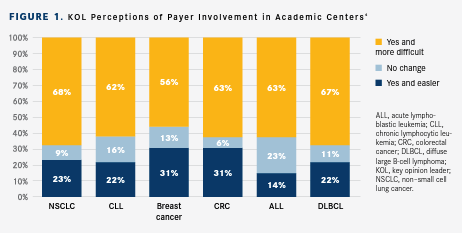Oncology Providers Face Rising Pressures From Payers Over Therapy Choices
Insurance companies are beginning to indirectly manage prescribing to better manage costs.

Historically, insurance companies have taken little action to manage oncology drugs and have left prescribing decisions largely up to provider preference, mostly because of the complexity and sensitivity of treating cancer.
It appears, however, that the companies are beginning to indirectly manage prescribing to better manage costs. Namely, they are shifting financial risk to providers and, in doing so, are trying to push providers to consider cost effectiveness, as well as the efficacy and safety of treatments. If providers are forced to consider cost to a greater extent, payers reason, they may begin to do more robust clinical and cost-effectiveness analyses to inform their decision-making.
The cost of oncology treatment is high and rising in the United States. For example, the monthly price of novel oncology drugs increased on average by 9% annually, and the average monthly cost of oncology drugs more than doubled between 2006 and 2015, from $7103 to $15,535.1 This raises the question whether insurance companies will begin to employ new tactics to influence provider-prescribing decisions toward lower-cost treatment options.
To this end, Two Labs conducted a survey of 120 oncologists practicing in the United States to better understand the extent to which insurance companies are placing financial pressure on them and how this influences their prescribing decisions.2
As a follow-up, an oncologist at a large academic treatment center participated in a multidisciplinary panel that included representatives from an insurance company and from manufacturers of oncology medications.
Increasing Financial Pressure
The survey findings suggest that across 6 major oncology indications—non-small cell lung cancer, chronic lymphocytic leukemia, breast cancer, colorectal cancer, acute lymphoblastic lymphoma, and diffuse large B-cell lymphoma—prescribers at large academic institutions believed that payers have increased the financial management of oncology therapies, making it more difficult to prescribe their first choice of therapy. (Figure 1).
Figure 1

In addition, the findings confirm that prescribers are feeling increased financial pressure. The participating oncologist, whom Two Labs is not identifying in this article, is aware of an increase in payer management in recent years, noting that she has had to change her first-choice medication about 20% of the time.
Pathways of Care
Pathways of care are a new management tool that have emerged in recent years as an attempt to curtail the increasing costs of oncology drugs by recommending which ones to prescribe in early and late lines of thera-pies. Payers incentivize providers to follow pathways by either offering upside financial rewards for compliance or downside risks for deviating from recommendations.
The survey findings suggest that pathways of care often strongly recommend or mandate the use of certain high-cost drugs over others, for example, a PD-1 inhibitor such as Keytruda (pembrolizumab) over nivolumab (Opdivo) or ipilimumab (Yervoy).
Although in theory care pathways may be useful in standardizing care, noted the oncol-ogist, in reality, each patient requires an individualized treatment approach. She has not seen any evidence that following such pathways leads to better patient outcomes and also suggests that pathways can quickly become dated and not accommodate the rapidly changing landscape in oncology. Initially, she was expected to adhere to pathways 70% of the time and there were only upside financial incentives. Then, adherence expectations increased to 80% and negative penalizations were introduced.
Another challenge for providers is that they must often juggle multiple pathways from different insurance companies, and in some cases from their institution as well. In some cases, providers juggle more than 3 pathways. The panel’s oncology provider handles multiple pathways. This causes her to choose the “least common denominator” treatment option, the one most likely to be covered on all pathways.
Shifting of Financial Risk
The survey results suggest that payers are shifting financial risk to providers, with 73% of providers suggesting they agree or strongly agree with the statement that insurance companies have been shifting financial risk to their hospital system/practice. This trend is even more marked among prescribers at large academic centers, with 78% of the providers agreeing with the statement.
Of respondents who agreed or strongly agreed with the statement, 66% said that this caused them to reconsider prescribing decisions. The most common way providers experienced this is through bundled payments. Often, they also face cost penalties, and in some cases financial risk is shifted through upside bonuses (Figure 2).
Figure 2

The panel’s oncologist has also experienced the shifting of financial risk. Her institution participates in the Oncology Care Model (OCM), which was introduced in 2016 to help providers lower cost while improving quality of care. There are currently 138 practices and 10 payers participating in the OCM.3
The oncologist notes that cost savings do not always capture the true value of care, as more effective therapies often have greater toxicities, which can be costly to manage.
Anne Runyon is a senior market access consultant at Two Labs, a pharmaceutical services company.


%201%20(1)%20copy.jpg?fit=crop&auto=format)

